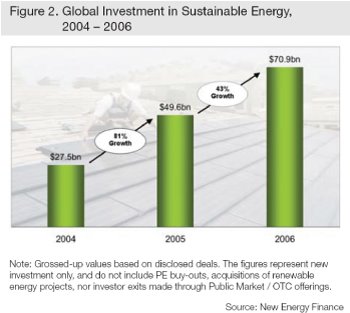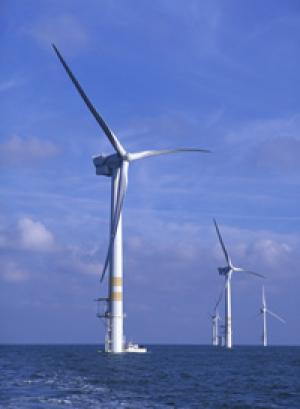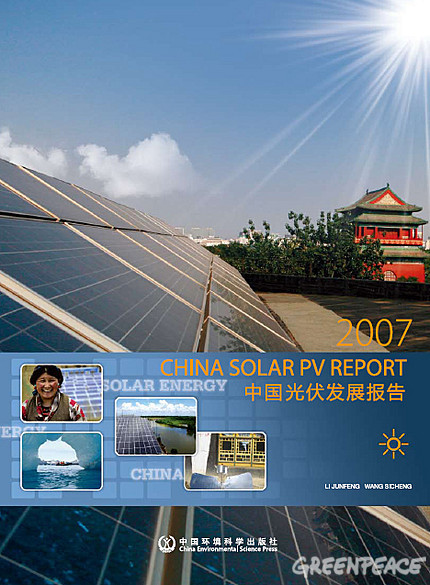Andrew DeWit and Janet L. Sawin
Renewable Energy: China and the US Rise, Japan Declines
Andrew DeWit
We are in a period of transition involving a protracted energy crisis and an energy revolution evidently on the way as well. Oil prices have blown through US$ 100/barrel, and it is anyone’s guess if and when they’ll drop below three figures again. Even if oil prices do decline significantly through what appears to be a deep recession in the United States, swelling demand in the BRICs (Brazil, Russia, India, China) and elsewhere will likely bring them back up and over 100 dollars in a matter of months. On top of that, the evidence of a global environmental problem increasingly reads like dystopian fiction. The February 21 midterm report of the latest comprehensive study of global warming (the Garnaut Review) warns that we must be well on the way to making deep cuts in CO2 emissions before 2020 or the “show will be over.” In short, we face escalating energy and environmental costs in the twilight of the oil age.
Small wonder that energy alternatives are attracting growing public- and private-sector investment. We see this investment at work in the following executive summary of a new report on renewables by the Worldwatch Institute and the REN21 (the Renewable Energy Policy Network for the 21st Century). There was reluctance to put serious money into renewables until recently, largely due to concerns about their practicality and the risk that fossil-fuel prices would decline and render renewables uneconomic. But the public sector has stepped in to alleviate the risk: about 60 countries and many more localities or states have adopted renewables targets and robust mechanisms to gear up domestic industries in order to meet those targets.
The executive summary shows that the German use of the feed-in tariff (FIT) for encouraging renewables in power generation is paying off handsomely. Among other benefits, in 2006, German renewables prevented the release of 100 million tons of CO2, employed 200,000 people, and brought EUR 6 billion worth of net gains via lower fuel imports, improved environment and health, and reduced wholesale costs for power.
We also learn that China, which has been making headlines as a menacing polluter in step with its surging oil and coal consumption, is rapidly emerging as a leader in renewables, and may be the world’s top-runner in a few years. China has 65 percent of global capacity in solar thermal for heating water (40 million systems in place), annual doubling of wind-power capacity, and a skyrocketing production and use of solar power. If China’s global search for oil and natural gas has driven up the prices of these fuels, Chinese research and production seem likely to drive down prices for solar and other renewables, thus making their diffusion even more rapid and widespread than at present.
One other point that is striking about this report is the virtual absence of Japan. Japan is not ignored in the full report and its data tables, as can be seen by downloading it via the link at the bottom of the summary. Japan even has respectable levels of installed renewables as well as production capacity (especially in solar). These are the first fruits of programmes instituted in the mid-1970s and the 1980s to develop solar and other renewables and commercialize the technology. But just as the decades of nurturing the industry were beginning to pay off, and just as competitors such as China and Germany were reaping serious gains from their own renewable-support systems, the Japanese central government lost interest. It shut off its subsidies and failed to adopt meaningful targets or to establish guidelines to assure reduction of fossil fuel emissions. Given Japan’s exposure to the energy crisis (above all its dependence on costly Middle East oil) and climate change plus its plus its past investment in renewables, it should be the focus of this article. But it isn’t because of a combination of market fundamentalism and the political economy of road building, the preoccupation with nuclear power, and other unwise fiscal priorities. Japanese experts are only now beginning to recognize that China’s advantages in talent and market scale might see it drive Japan out of a ranking place in renewables and the energy-efficiency fields as well. It seems high time for Japanese leaders in the LDP, Keidanren, the power sector, and elsewhere to reflect on their own country’s past in using the state to shape markets and foster industrial change. They might also have a look around in the present, at this report perhaps, and note that just about everybody else is doing it, and that some are doing it very well.
Andrew DeWit is Associate Professor of Economics at Rikkyo University in Tokyo and a Japan Focus coordinator. He wrote this article for Japan Focus, Posted March 18, 2008. The author can be contacted at [email protected].
Are Renewables Approaching a Tipping Point? Highlights from the REN21 Renewables 2007 Global Status Report
Janet L. Sawin
The REN21 Renewables 2007 Global Status Report presents information about the current status of renewable energy around the world. The report is a joint project of the Worldwatch Institute and REN21 (the Renewable Energy Policy Network for the 21st Century) and was initiated in 2005. The 2007 edition is the third in the series.
This year’s report finds a dynamic, rapidly growing renewable energy sector, with the economic gap between renewables and fossil fuels closing quickly, thanks to rising oil prices and growing recognition of the high cost of carbon emissions. As a result, investing in renewables is no longer just about “doing the right thing” and being green, but also about making green—and global investment trends reflect this thinking.
Investment growth rates have been accelerating for the past several years. In 2006, investment in new renewable electric and heating capacity came to $55 billion, climbing to a record high of some $71 billion in 2007. This is on top of tens of billions of dollars in capital investments in new manufacturing plants and equipment, and public and private funding for research and development—for a total investment flow exceeding $100 billion in 2006 and 2007.
Annual global investment in new electric and heating capacity is now about five times what it was in 2000, and it has risen almost 10-fold since 1995—the first year for which we have data. Wind power has become the dominant technology, with a 47 percent share for 2007, followed by solar photovoltaics (PV), at 30 percent. In fact, wind, PV, and solar thermal systems for water heating made up more than 85 percent of the global total in renewables investment in 2007.
Market Trends
These investments are driving the marketplace. We estimate that total renewable power capacity (excluding large hydropower) increased by 33 gigawatts (GW) in 2007, to 240 GW worldwide. It’s remarkable that this is almost 50 percent higher than the global total just three years ago (in 2004). Including large hydropower, renewables now provide more than 1,000 GW of electric power capacity; this compares to about 4,300 GW of total global power capacity.
Wind and solar PV combined account for about two-thirds of global market growth in renewables in 2007. Installed capacity of PV is still relatively low: there were about 10.5 GW of PV operating worldwide by the end of 2007. But PV is growing at breakneck speed and has rapidly become one of the world’s fastest growing industries. Over the past five years, capacity has risen by an average of 36 percent annually; grid-connected PV is rising far faster, with annual growth rates exceeding 50 percent in 2006 and 2007.
Growth in wind capacity continues to be strong as well, thanks in great part to the United States, which installed a record 5.2 GW in 2007, greatly exceeding early projections. Worldwide, the wind industry brought on line about 15 GW of new capacity in 2006, and added another 21 GW last year—compared with only 1 GW of new nuclear power capacity that came on line around the globe in 2006. Wind power has grown an average of more than 24 percent annually over the past five years, and global capacity totaled approximately 95 GW by the end of 2007. More than 70 countries now use the wind to generate electricity, including many developing countries that have recently come on board, such as South Africa, Mexico, and Iran.
Global capacity of small hydropower and biomass power came to 73 GW and 45 GW respectively by the end of 2006. Solar thermal for power generation is another promising technology that is again seeing growth, with new projects in the United States and Spain. And solar thermal for water heating continues its rapid rise. Rooftop solar collectors now provide hot water for more than 50 million households worldwide.
Biofuels production was up about 18 percent in 2006, with similar growth in 2007. As with wind, growth is being driven largely by the United States, which passed Brazil in ethanol production in 2005, and by Germany, which leads the world in biodiesel production. But the race is on as Brazil now has an ambitious program to increase sugar cane-based ethanol production 50 percent by 2009. And many other countries in the European Union, Africa, and Southeast Asia are becoming established biofuels producers.
Although renewables still represent a fairly small share of global energy demand, they are growing rapidly. Renewable power capacity (excluding large hydropower) represents almost 5 percent of total global power capacity, and its share is rising. And, of course, the contribution of renewables is already far higher than this in many countries.
The surge in production of ethanol and biodiesel in 2006 accounted for 17 percent of the increase in supply of all liquid fuels worldwide last year, and this share is likely to rise in coming years as well.
National Policies
Helping to drive these high growth rates, at least 64 countries now have national targets for renewable energy. At least 60 countries have policies to promote renewable electricity, while at least 53 countries, states and, provinces have biofuels mandates. Many of these targets and policies are in developing countries, and several additional developing nations are in the process of enacting policies. Worldwide, incentives for renewables exceed $20 billion per year, and it’s estimated that more than half of this is now going to biofuels.
Renewable portfolio standards and feed-in policies are spreading to an increasing number of countries, states, and provinces around the world. And many are having a significant impact. Just to give one example, thanks mostly to Germany’s feed-in law, the share of electricity from renewable sources there increased from 6.3 percent in 2000 to 12 percent in 2006. It’s estimated that renewables provided more than 14 percent of Germany’s gross electricity consumption by the end of 2007, well ahead of official targets for 2010. As a result of this success, the German government recently announced increased targets for renewables to account for 25–30 percent of electricity by 2020 (up from 20 percent), and some proposals now call for a target of at least 45 percent by 2030.
China Taking the Lead
China is without a doubt the biggest story in renewable energy in the past year. Based on current trends, China could well be the world leader in renewable energy within the next three years.
Following are a few key trends:
First, China continues to lead the world in production and use of solar thermal for water heating, with more than 65 percent of global capacity by the end of 2007. Today, more than one-tenth of China’s households rely on the sun to heat their water. China has more than 40 million solar thermal systems in place.
Second, wind power capacity increased at least another 2 GW in China last year (by some estimates the growth exceeded 3 GW). This means that, for the second year running, China doubled its installed capacity of wind. The average growth rate for wind power in China since 2004 exceeds 80 percent per year.
But solar PV is the biggest surprise. China is seeing the emergence of a dynamic solar manufacturing industry. Just three years ago, in 2004, China produced about 65 megawatts (MW) of PV. In 2007, it was expected to manufacture more than 1,500 MW. And more than 4,000 MW of new PV are expected in 2010—or far more than the entire world produced in 2006. China’s entry into the industry will likely have far-reaching implications, by helping to drive down prices dramatically and making PV more affordable in markets across the globe.
Most solar PV manufactured in China today is for export—with the majority going to Germany and Spain. But PV use is rising in places like Rizhao, a city of about 3 million people in China’s northeast that powers most of its outdoor lighting and heats almost all of its water with the sun. The city’s leaders see solar energy as a starting point for sparking social, economic, and cultural development through a cleaner environment—and they are already seeing great benefits.
Cities Turning to Renewables
Rizhao is among a growing number of cities around the world that are investing in renewables and energy efficiency, setting targets, and even establishing mandates for renewable energy use.
From Portland, Oregon, to New York City; from Adelaide, Australia, to Vancouver, Canada; and from Cape Town, South Africa, to Daegu, Korea, cities are going green. And they are doing this thanks to a growing realization that energy choices can achieve a number of goals, including: reducing the threat of climate change, creating new local jobs, ensuring more secure and reliable energy supplies, and improving the natural environment and health of their citizens.
The Many Benefits of Renewables
Renewables are already providing enormous benefits to millions of people around the world, in addition to the energy that they produce.
Worldwide, more than 2.5 million people now have jobs in the renewable energy sector. In 2006, well over 200,000 people were employed in renewables industries in Germany alone.
Although global estimates are not available, the German government estimates that renewable energy avoided the release of more than 100 million tons of carbon dioxide (CO2) in Germany in 2006—that’s equivalent to taking more than 18 million U.S. cars off of that nation’s roads. Renewable energy is available now to be rapidly scaled-up to meet the increasing demand for energy services around the world, and—in combination with energy efficiency improvements—it offers the greatest potential for short- and long-term reductions in CO2 emissions.
The net economic benefits of renewable electricity to German consumers now amount to about 6 billion euro per year, according to the German government. In other words, the benefits of fuel-import savings, environmental and health benefits of renewable electricity, and an associated decline in wholesale electricity prices all far exceed any additional costs to consumers of producing and using renewable power.
Renewables provide a host of other benefits as well, by helping to advance rural development in industrial and developing countries alike, improving energy security, and providing cleaner air and water and improved human health.
Conclusion
The above trends and others all tell us that renewables are close to a tipping point. And their potential is absolutely enormous, particularly in combination with improvements in energy efficiency. Moreover, we can get there quickly, as experiences in Germany and other countries demonstrate.
The challenge for all of us is to convince our political leaders of the potential of renewables, and indeed our great need for renewable energy. We must work together to create the political will and strong, consistent, and long-term policies that are needed to propel renewables into the mainstream.
This article appeared at the Worldwatch Institute on March 3, 2008. Janet L. Sawin – Senior Researcher – Director, Energy and Climate Change Program, Worldwatch Institute. View the full report here.
Posted at Japan Focus on March 16, 2008.











